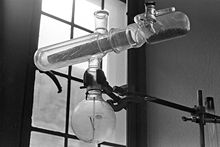- Abderhalden's drying pistol
-
Abderhalden's drying pistol is a piece of laboratory glassware used to free samples from traces of water, or other impurities. It is called a "pistol" because of its resemblance to the firearm. This apparatus was first described in a book edited by Emil Abderhalden.[1] The drying pistol allows the sample to be dried at elevated temperature; this is especially preferred when storage in a desiccator at room temperature does not give satisfactory results.[2]
Operation
The drying pistol consists of two concentric barrels; the inner is connected to a vacuum source via a trap.[3] The outer barrel is connected at the bottom to a round bottom flask, and a condenser. To operate the drying pistol, a sample is placed within the inner barrel, and the barrel is evacuated. The round bottom flask, filled with an appropriate solvent, is heated to a boil. Hot vapors warm the inner barrel; losses are avoided with the condenser. By choosing the appropriate solvent, the temperature at which the sample is dried can be selected.
The trap is filled with an appropriate material: water is removed with phosphorus pentoxide, acidic gases by potassium or sodium hydroxide, and organic solvents by thin pieces of paraffin. Generally, the main impurity to be removed is water.[2][4]
This set-up allows the desiccation of heat-sensitive compounds under relatively mild conditions. Removing these trace impurities is especially important to give good results for elemental analysis and gravimetric analysis.
References
- ^ Andrea Sella (2 2009). "Classic Kit: Abderhalden's drying pistol". Chemistry World. Royal Society of Chemistry. http://www.rsc.org/chemistryworld/Issues/2009/February/AbderhaldensDryingPistol.asp.
- ^ a b Dawkins, Linda M.; Shugar, Gershon J.; Ballinger, Jack T. (1996) (Google Books excerpt). Chemical technicians' ready reference handbook. New York: McGraw-Hill. pp. 311–312. http://books.google.com/books?id=89w4kyQqQXcC&pg=PA311&lpg=PA311.
- ^ Laurence M. Harwood, Christopher J. Moody (13 Jun 1989). Experimental organic chemistry: Principles and Practice (Illustrated edition ed.). WileyBlackwell. pp. 136–137. ISBN 0-632-02017-2, ISBN 978-0-632-02017-1.
- ^ Chai, Christina Li Lin; Armarego, W. L. F. (2003) (Google Books excerpt). Purification of laboratory chemicals. Oxford: Butterworth-Heinemann. pp. 25–26. ISBN 0-7506-7571-3. http://books.google.com/books?id=SYzm1tx2z3QC&pg=PA25.
Categories:
Wikimedia Foundation. 2010.

